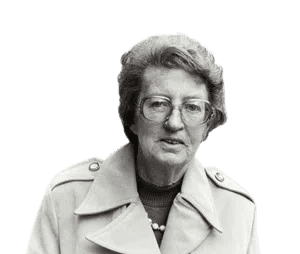Life and achievements
Early life
Mary Leakey was born on February 6, 1913, in London, England, and grew up in a family that was in the habit of moving from one country to another in Europe. Her father was Erskine Nicol, a watercolor painter, and her passion for archaeology began at an early age after being exposed to ancient ruins and prehistoric cave paintings in France. Her passion developed during her family’s travels through Egypt, Italy, and France. Indeed, in this region, in the south of France, she started picking up paleolithic tools and objects and thus developed an interest in archaeology.
Below-average academic performance—Mary was expelled from several schools—did not prevent her from becoming an illustrator and entering archaeology. Her accurate illustrations of the Stone Age implements and fossils acted as her entry ticket to her first dig under the supervision of Dorothy Liddell at Hembury in Devon.
These practical experiences in her early career taught her the precise methods of digging and handling artifacts. This foundation proved invaluable when she encountered Louis Leakey, a charming Kenyan-born paleoanthropologist, in 1933. Their working partnership quickly turned into a romantic one, and in 1936, they got married – beginning a union that would set the course for studying human evolution. They went on several missions across East Africa and later shifted to Olduvai Gorge, Tanzania, where they made discoveries that revised the human evolution timeline.
Legacy
The paleoanthropology world owes a lot to Mary Leakey. Zinjanthropus boisei (later renamed Paranthropus boisei), found in the Olduvai Gorge in 1959, put her and her husband on the world map. This find and the discovery of the Laetoli footprints later in 1978 made her one of the most essential paleoanthropologists in the study of early human evolution. The Laetoli footprints offered the first clue as to the nature of bipedalism and revolutionized the concept of early hominid evolution. These discoveries put Africa on the map of human evolution research, displacing earlier beliefs that people evolved in Europe or Asia.
Mary also did not only dig at Olduvai; she introduced a method of categorizing the stone tools, which helped analyze early human activities. After Louis’ death, Mary continued with the work, mentoring their son Richard Leakey, who also grew up to be a paleoanthropologist. In addition to her fieldwork, she authored several influential books, including Disclosing the Past, her autobiography, and Olduvai Gorge: My Search for Early Man. She was awarded many awards for her efforts, including the Hubbard Medal from the National Geographic Society and an honorary doctorate from Yale and Oxford.
Mary Leakey has not only made significant discoveries herself but also contributed immensely to the creation of the field of paleoanthropology and how people learn about human evolution. Gadeb’s legacy continues through her descendants and ongoing research at Olduvai and Laetoli. Reducing her accomplishments to an account of the facts is to miss the extraordinary person and her unique contribution to the study of human origins.
Milestone moments
May 15, 1936
Louis Leakey’s Marriage and Beginning of Professional Relationship
In 1936, Mary wedded Louis Leakey, which initiated their partnership in paleoanthropological research.
Together, their collaboration proved fruitful.
Mary’s meticulous digging capabilities complemented Louis’s more extensive scientific perspectives, resulting in significant discoveries in East Africa.
This was the beginning of one of the most well-known duos of spouses who worked together in the fields of archaeology and paleoanthropology.
May 16, 1948
In this case, a Proconsul africanus skull was discovered.
In 1948, Mary made her first significant fossil discovery on Rusinga Island, Kenya: the fossil of the skull of an extinct ape, Proconsul africanus, which lived 16 million years ago.
This discovery was important as it established one of the first connections between apes and humans, thus affirming Africa’s importance in the evolution of man.
The find started Mary as an independent paleoanthropologist and could be considered a new phase for both the Leakey family and paleoanthropology in general.
May 10, 1959
The discovery of the Zinjanthropus boisei fossil in Olduvai Gorge
The well-preserved skull of Zinjanthropus boisei (Paranthropus boisei since July 17, 1959, by Mary Leakey in the Olduvai Gorge, Tanzania.
It was dated 1.8 million years ago and provided strong evidence that early hominids occupied East Africa, thus changing the research agenda.
The discovery attracted considerable attention and later facilitated the search for funds for further excavation, making Olduvai Gorge one of the most essential paleoanthropological sites.
Jul 23, 1972
Death of Louis Leakey and Further Research
After her husband Louis’s death in 1972, Mary Leakey took over field research management at Olduvai Gorge.
She remained active in the field and continued to establish her authority in paleoanthropology when Mary started working independently.
She was the one who came across perhaps one of the most critical discoveries in man’s evolution, the Laetoli footprints.
